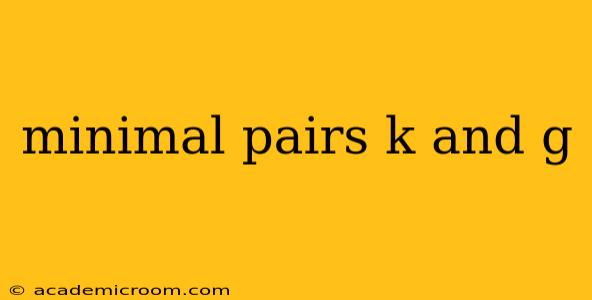Understanding minimal pairs is crucial for mastering pronunciation, particularly in languages like English, where subtle sound differences can drastically alter meaning. This post delves into the minimal pair distinction between the voiceless velar plosive /k/ and the voiced velar plosive /ɡ/, exploring their pronunciation, common confusions, and practical exercises to improve your grasp of this often-tricky phonological element.
What are Minimal Pairs?
Before diving into /k/ and /ɡ/, let's define minimal pairs. Minimal pairs are words that differ by only one phoneme – a single sound unit. This single sound change results in a completely different word with a different meaning. For example, "bat" and "cat" are a minimal pair, differing only in the initial consonant sound (/b/ vs. /k/). This clearly demonstrates the importance of precise pronunciation.
The Sounds /k/ and /ɡ/: A Detailed Look
Both /k/ and /ɡ/ are velar plosives, meaning they are produced by stopping airflow at the velum (soft palate) before releasing it. The key difference lies in voicing:
-
** /k/ (voiceless velar plosive):** This sound is produced without vocal cord vibration. Think of the "k" sound in "kite," "cake," or "back." Notice the absence of any humming sensation in your throat.
-
** /ɡ/ (voiced velar plosive):** This sound involves vocal cord vibration. Think of the "g" sound in "gate," "game," or "bag." You should feel a slight vibration in your throat as you produce this sound.
Common Confusions and Errors
Non-native speakers often struggle with the distinction between /k/ and /ɡ/, particularly when these sounds appear in similar phonetic contexts. This is because the subtle difference can be easily missed if not consciously practiced. Common errors include:
- Substituting /k/ for /ɡ/: This can lead to mispronunciations like saying "kite" instead of "gite" (a hypothetical word, but illustrates the point).
- Substituting /ɡ/ for /k/: This could result in mispronunciations such as saying "gate" instead of "Kate."
Minimal Pairs: /k/ vs. /ɡ/
Here are some quintessential minimal pairs showcasing the crucial difference between /k/ and /ɡ/:
| /k/ Word | /ɡ/ Word |
|---|---|
| cat | gat (archaic, but illustrative) |
| kite | gite (hypothetical) |
| coat | goat |
| cup | gup (slang, but illustrative) |
| cool | gool (hypothetical) |
| kick | gick (hypothetical) |
| cake | gage |
How to Improve Your Pronunciation
Mastering the distinction between /k/ and /ɡ/ requires diligent practice. Here are some effective strategies:
- Mimic Native Speakers: Listen carefully to native English speakers pronounce words containing /k/ and /ɡ/. Pay close attention to the subtle differences in voicing.
- Record Yourself: Record yourself pronouncing the minimal pairs listed above. Compare your pronunciation to that of a native speaker. Identify areas needing improvement.
- Focus on Voicing: Consciously focus on the vocal cord vibration when producing the /ɡ/ sound. Feel the vibration in your throat.
- Practice Regularly: Consistent practice is key. Incorporate these minimal pairs into your daily speech practice.
Why is mastering /k/ and /ɡ/ important?
Accurate pronunciation of minimal pairs is vital for clear communication. Mispronunciation can lead to misunderstandings, hindering effective communication, particularly in spoken English. Improving your pronunciation shows attention to detail and demonstrates a higher level of linguistic proficiency.
What are some common words with /k/ and /g/?
This question highlights the need for practical examples. Many common English words utilize both phonemes. Examples include: keep, go, king, girl, cake, game, quick, argue, and many more. Understanding their subtle differences enhances comprehension and overall fluency.
This comprehensive guide provides a solid foundation for understanding and mastering the minimal pair distinction between /k/ and /ɡ/. Consistent practice, coupled with attentive listening, will significantly improve your pronunciation and overall English language proficiency.
